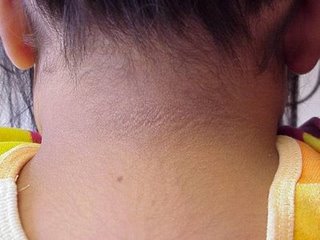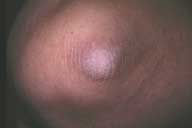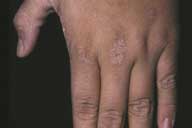
Acanthosis Nigricans on Nape of Neck. This picture shows a mild case of acanthosis nigricans (AN) on the nape of the neck. AN can also appear on the groin, under breasts, chest, and even on the scalp.
What is acanthosis nigricans?
Acanthosis nigricans (AN) is (usually) a benign skin condition typically characterized by hyperpigmentation (darkening of skin pigment) often accompanied by a velvety change in texture of the skin that is affected.
Acanthosis nigricans is often seen in obese patients with insulin resistance and is often associated with pre-diabetes and type 2 diabetes.
If you see changes in skin color or texture it is important to see your doctor. Â A dermatologist may be able to diagnose acanthosis nigricans, but to diagnose insulin resistance or another underlying metabolic medical condition (including polycystic ovarian syndrome or pre-diabetes or type 2 diabetes) that could be causing skin changes you should see an endocrinologist.

AN can sometimes appear on the elbows (or knees). It may even be mistaken for psoriasis or appear in conjunction with psoriasis.
What parts of the body does acanthosis nigricans affect?
It most commonly appears in body folds like under the arms, groin, and back of the knees. But acanthosis nigricans can appear almost anywhere on the body including the scalp, hands, elbows, and nipples.
What causes acanthosis nigricans?
Acanthosis nigricans is most often caused by hyperinsulinemia (elevated levels of insulin) due to insulin resistance. Acanthosis nigricansis most commonly seen in obese people but can occur in any patient that is insulin resistant.
Acanthosis nigricans may be diagnosed by a dermatologist when a patient mistakes acanthosis nigricans for another skin condition. Acanthosis nigricans is almost always benign (non-cancerous) but in rare cases can be serious. Skin tags often appear in the same patients who have acanthosis nigricans.

Underarm AN.
Acanthosis nigricans in the underarm area may become quite dark but can also appear like a mild, yellowish-tan stain.

Acanthosis nigricans on a hand.
Acanthosis nigricans can also appear on the palms and back of the hands. It may even be mistaken for psoriasis or appear in conjunction with psoriasis.


